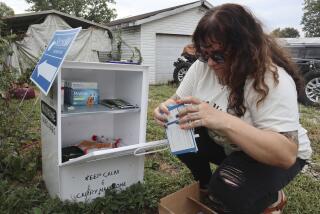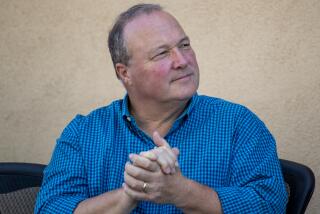Drug users’ union in San Francisco part of growing movement
Reporting from San Francisco — Heroin shooters, speed users, pot smokers and even some men and women who now are drug-free convene regularly in this city’s gritty Tenderloin district — not for treatment, but to discuss public health policy and share their experiences free from shame or blame.
On this particular evening, the dozen or so in attendance had some pressing questions, including how those heading to a users’ conference in Oregon this fall would obtain their methadone or safely procure other drugs to use in a supervised injection room.
“We have to figure that out,” said Isaac Jackson, the group’s senior organizer. The 56-year-old, who holds a doctorate in media arts and sciences from MIT, turned to speed in his mid-30s. “Nobody should [skip] this conference because they’re afraid they’re not going to get their dose.”
This is the San Francisco Drug Users Union, one of a few such groups in the U.S. and part of a growing worldwide movement of thousands who, according to the International Network of People Who Use Drugs, are demanding a voice “in decision-making processes that affect our lives.”
In the coming months, members of the San Francisco group plan to testify before a city panel on housing discrimination; co-host the first conference in the U.S. by and for drug users; and hold a design contest for a safe-injection site similar to one in Vancouver, Canada, where public health workers provide sterile needles and intervene in cases of overdose. They also have crafted a manual for medical personnel, to be released later this month, in hopes that drug users will get better emergency care.
The group’s ultimate goal is decriminalization, an unlikely prospect but one increasingly debated by policy analysts who contend that the four-decade “war on drugs” has exacerbated social ills.
Linked to the harm-reduction movement — a philosophy that aims to reduce disease, injury and death among drug users without passing judgment or demanding abstinence — the union mostly hopes to put a face on those whom, Jackson said, “most people despise.”
“People say, ‘You’re a drug user, you brought this on yourself,’ ” Jackson said. “Do people say that when you’re 300 pounds with heart problems from eating McDonald’s every day?”
Barbara Garcia, director of San Francisco’s Department of Public Health, opposes the injection site for now but said she welcomes the union’s organized advocacy. “We may not be able to always give them what they want,” Garcia said, “but we’re here to listen.”
The union — with about five dozen members who attend meetings — eschews words like “addict” and “abuser.” It neither encourages nor discourages use. At the recent meeting, one man who took a long bathroom break emerged to alternate between dozing on the couch and scratching himself, signs of an opiate high.
Jackson said that injecting is not condoned at either the biweekly meetings or in individual workshops, but “we know who our members are.” A biohazard box is available in the bathroom for dirty syringes. The door latch is flimsy by design so it can be opened if someone hits the floor.
The rules are simple: No dealing at meetings. You can be high, but don’t be disruptive.
San Francisco police haven’t interfered with the union’s activities, focusing drug enforcement on dealing and related street crimes. Reflecting that ethos, San Francisco Dist. Atty. George Gascon recently said that he believes drug use “is a health problem, not a crime problem, and should be dealt with accordingly.”
The leaseholder on the cozy office space members call their “community living room” is the Harm Reduction Therapy Center, which also provides the union with financial support. The rug is faded, the couch comfortable and the walls covered with straight-talking pamphlets about drugs, disease and overdose. Anyone who seeks treatment can easily find it.
The harm reduction philosophy has deep roots in this city, whose public health department in 2000 was the first in the nation to adopt the approach. The city funds an overdose prevention education group that prescribes antidotes and provides training on administering them to opiate users. San Francisco General Hospital has established a wound-care clinic for injection drug users.
Half an hour before a recent meeting, the center’s security gate creaked open and Gary West, who became a paid organizer after proving himself a reliable and enthusiastic union member, welcomed others as the blues wafted from a small boom box. There is an easy vibe of shared affinity.
Skyler Foster, 53, has been a regular since he heard about the union two years ago while at a clinic that treats and educates drug users with Hepatitis C.
A gaunt man with graying hair, Foster weighed in on the group’s medical manual and asked about the upcoming design contest for the injection site.
“It’s important that this type of advocacy is around,” Foster said. “You go in, you get shot down, and you feel like crap when you come out of these hospitals.”
Lydia Blumberg, 34, no longer uses methamphetamine but said she felt a weight lifted the minute she walked into her first union meeting. An arrest record for “being high in my own house” has prompted landlords to turn her away, she said. Yet the deepest wounds come from what she described as society’s demonization of drug users.
“I felt I didn’t deserve to be loved or respected by people who didn’t use illegal drugs,” Blumberg said.
Drug users unions first took shape in the Netherlands in the 1970s with the Junkiebonden, which sought to stem the spread of Hepatitis C through distribution of clean needles, said Merrill Singer, a University of Connecticut anthropologist.
The HIV/AIDS epidemic added urgency to such efforts, and in time groups led by public health advocates took root in Europe, Australia and Canada. The Vancouver Area Network of Drug Users, now funded by public health officials, was formed in 1998 and played a key role in creating the Western hemisphere’s first — and so far only — safe-injection site in 2003. Europe has nearly 100 such facilities.
The movement is relatively new to the U.S., Singer said, because of “racism and class discrimination, which are intimately bound together in our conception” of drug users.
America’s first official drug users union formed in New York in 2005, followed by one in Seattle that more recently morphed into the Urban Survivors Union.
The seed was planted in San Francisco — which decades ago pioneered a needle-exchange program — after Jackson attended a city-sponsored conference in 2007 to explore the possibility of a safe-injection site. He and two others got a grant from the national Drug Policy Alliance, which continues to fund the union and seeks to roll back what it considers “excesses of the drug war” that have led to high incarceration rates, particularly among minorities.
The union held its first meeting in 2010.
Jackson, who breaks easily into a mischievous grin and favors offbeat T-shirts, jokes that his regularly offered safety tips have led others to view him as “the Boy Scout of drug users.” He still uses but said his approach is more responsible than in his younger days. “I’m being myself,” he said. “I’m being an example to other users.”
Whether the union’s agenda will advance is an open question.
San Francisco Mayor Ed Lee balked last year at a task force recommendation supporting a safe-injection site, and Garcia believes no neighborhood will accept one. Yet Lee plans to visit Seattle to learn about its “wet house,” where homeless alcohol abusers are able to drink freely while receiving counseling and support to help them cut back.
To Dr. Eric Woodard, San Francisco General Hospital’s medical director of psychiatric emergency services, “treating underserved, vulnerable populations is part of our mission.” Woodard’s staff and union members have begun working together, sharing information about batches of bad street drugs. “I think it’s good that they’ve banded together to make their needs known,” Woodard said of union members.
To many users, that respect is key.
West moved here from Detroit after hearing about the union.
Although he was homeless, he spent his days volunteering — walking for miles distributing fliers for the group. He said he went to Haight-Ashbury for “historical value” and Fisherman’s Wharf because the notices tickled tourists. Two years later, West has a place to live and a paycheck.
“It gave me something to belong to,” said West, 48. “It let me say what I know without the stigma and the frowns. This … turned around my whole life.”
More to Read
Sign up for Essential California
The most important California stories and recommendations in your inbox every morning.
You may occasionally receive promotional content from the Los Angeles Times.











